Conversations with Underwater Photographers: Christian Vizl by Henley Spiers
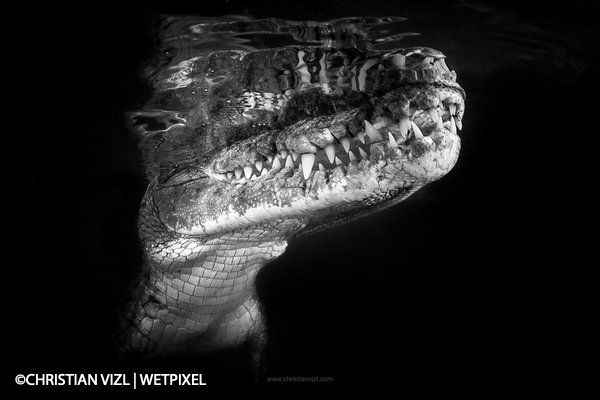
Christian Vizl - Interview by Henley Spiers
I’ve just come back from an incredible trip to Baja Mexico where the marine life was bountiful, and I had the privilege of shooting alongside one of my favorite underwater photographers: Christian Vizl. He has an extremely distinctive style of (mostly) black and white photography and, to me, is the finest proponent of underwater imagery as art on the scene today. Over the time we spent together we had some transformative discussions which have materially benefitted my underwater photography and, on the last day of the trip, we sat down for this interview which I hope will serve as inspiration for some of you other underwater shooters out there.
Henley Spiers: What came first for you: diving or photography?
Well, first of all, it was love for the ocean, that came first and then from there I was always dreaming about becoming an underwater instructor because I knew that that was the only way I could dive as much as I wanted to. That came a little bit late in my life actually when I was around twenty, but I started also taking pictures above water when I was about 15.
So both of them came at about the same time?
Yes, but underwater photography came very late, only in about 2010. That’s when I bought my first camera and took it underwater.
What was your diving and photography journey in between becoming a dive instructor in your twenties and getting that first underwater camera in 2010?
Yeah, so in 1994 I did my first open water dive, the one that I had been dreaming of all my life, and then in 1997 I became a diving instructor and all that year, I was teaching diving in Southeast Mexico, in a place called Akumal. It was a wonderful place, and I have very fond memories from that time. And then I went one year to Australia and then back to Mexico City and did some other stuff but I was always diving a little bit, not professionally anymore, but I was taking trips all the time. It wasn’t until around 2008 on a trip to Belize, I was diving with a friend of mine, he’s a videographer, and at some point we were diving together over a sandy floor, and he just gave me his camera, but he didn’t come back, so I turned it on and started shooting video. That was my first experience underwater with a camera, and it changed everything, it was like a completely new experience of being underwater, and then I got the bug you know. I started to dream about buying a camera and bringing it underwater, and that happened a couple of years later.
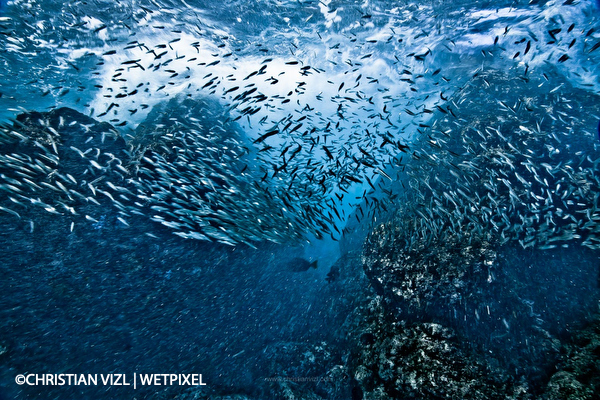
So that moment was the first turning point regarding your underwater photography?
Yeah because it was the moment that two of my passions came together for the first time and I could feel this powerful feeling you know. Wow! This is something I want to do more.
Why did you and why do you want to take underwater photos?
It has changed a little bit with time but there is something that remains, and it is the basic core of what I do, and it’s because photography is just a means, a pretext to be exactly where I want to be, which is in front of the animals. Nothing compares to that. That’s the ultimate thing for me, to have those experiences and to try to have some kind of communication with any animal underwater — big, small, it doesn’t matter I love them all, and I find beauty in all of them, each one, I think they are just fantastic! So that comes first, and it’s still like that, it’s just a pretext taking pictures to be exactly where I want to be. Then it also has become very interesting for me what you can achieve through photography because photography has a power in itself and it has the power to change the way people perceive, and the way people see the underwater world or anything that you choose to photograph. So I am very excited about that possibility with photography and using it towards ocean conservation.
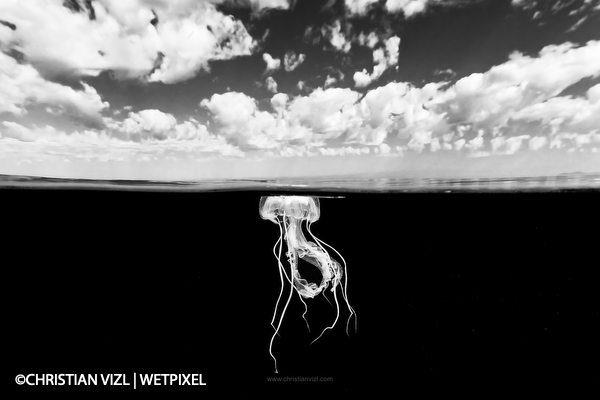
You have a super distinctive style and you are best known for your black-and-white imagery. With the black-and-white, that’s how you saw the ocean from the start, or that developed over time?
Yeah, black-and-white has always been my favorite style in photography, and when I was a kid I was always inspired by black-and-white photographers, all kinds of styles, landscapes…you know…Ansel Adams…or people…you know, Henri Cartier-Bresson…and underwater of course: David Doubilet, Ernie Brooks, and so many others that I was always inspired by, but especially black and white, and that’s always been my favorite choice for photography.
Why is black and white so special for you?
I find there’s a much broader and deeper way of connecting with people or actually connecting with yourself and your emotions and with whatever you are trying to say through your photography. I find it has a broader means to express feelings and emotions and I find there is a much more impactful, visual storytelling through black and white photography.
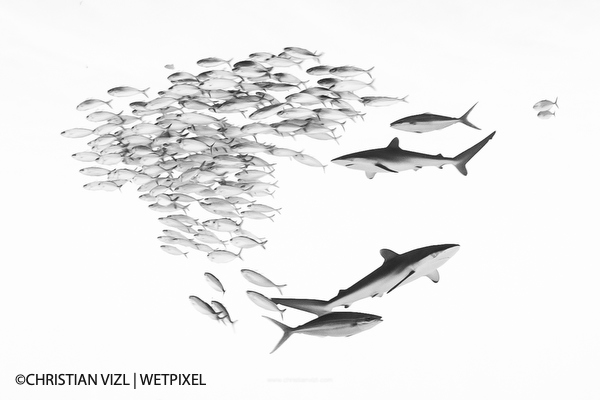
Do you think people sometimes misunderstand black-and-white photography?
Yeah in many cases I think they do and a lot of people that I’ve heard a lot of comments such as “Ahh my photo that doesn’t look very good in color…I just put it into black and white,” but I think they don’t really understand what it really takes to make outstanding black and white photography. It’s a way of seeing the world, not just converting color to monochrome. It’s a way of seeing your scene, and how you structure your scene, and how you compose your scene, what you look for when you’re shooting. It varies a lot whether you are shooting for color or for black and white.
**And, just to step into the technical realm for a moment, of course, every image is going to have some difference, but what is your technical, methodological starting point when you go out and shoot?***
Technically speaking it’s better to shoot in color because of the way the sensors work. Once you turn that into a black-and-white image, you will have a broader spectrum of grey if you shoot it in color. But keep in mind that my eyes they see in black and white, the scene, you know, I try to visualize how they’re going to work - the contrasts, the form, the texture - which are so important for black and white.

We’ve been diving together for a couple weeks now and there are a couple of very interesting things that I’ve noticed about the way at you shoot most of the time, which go against what I think is conventional wisdom right now in the underwater photography world: you don’t tend to shoot in pure manual mode, and you don’t use your strobes very much. Can you explain a little bit more why that is?
Sure, well regarding the strobes I’ve always loved natural light. I think it is so much more dramatic and it is such an amazing way to create images, using natural light. I always look first for natural light. I only use flash in case some images can benefit from a little bit of flash here and there - but I prefer a lot more natural light. Regarding shooting manual, at the beginning, I was shooting manual because it’s a good idea to try to keep as much control as possible over your camera and your technique to get your final result. But I stepped away a little bit from that control because I was losing so many moments and, in underwater photography, with certain animals, you only get one chance if you’re lucky to get the perfect timing. Remember what Cartier-Bresson said to all of us: look for the moment. The moment is very important in all kinds of photography, and of course, it also applies to underwater photography, so if you miss the animal for a split second, you might miss the tail, you know, the way it reflects the light from the sun. You know every little detail counts, and so you spend all this time and money and effort going to these trips to be in front of the animals, and the condition vary greatly underwater because you don’t know where the animal is going to go most of the time (unless you’re shooting macro or a very steady animal - then you can keep the whole control) but with fast moving animals sometimes you’re against the sun, sometimes you’ve got the sun on your back and, if you’re trying all the time to adjust your settings your mind is going to be full of technical complications. It’s going to be scrambled. So I chose to only control certain aspects of the image by shooting in shutter-priority so I control the speed and I can control many things with the exposure compensation. I can set the tone of the blue and how that’s going to translate into grey scale. If I want a darker or lighter grey for the background, I can control that. In that way I can free my mind and focus on what is really super important: to try to get the exact moment when the animals are performing a super unique shape, form, activity or whatever. It’s just a matter of freeing my mind to focus on very specific and very important other aspects of photography.
And do you have a pre-dive or a pre-in water ritual?
Sometimes, sometimes, not all the time. Sometimes before going on a trip for maybe three or four days before I stop looking at the newspapers or news in general because there’s so much violence and it affects the way we feel, and I’ve found out that that, in turn, affects the way I shoot and the quality of the images. Sometimes I watch only very specific images that are going to inspire me, or movies, or read poetry, or things that will uplift my spiritual self. Sometimes before going in the water, if there is a nice boat ride in the morning, I do some meditation where I try to clear my mind of all thoughts, just try to be present in the moment and try to be open for creativity to flow. Imagine your brain like a highway, if there are too many cars you’re going to be stuck, you have to try to free that highway to let the creativity flow, to enjoy the experience, and to connect with the animals.
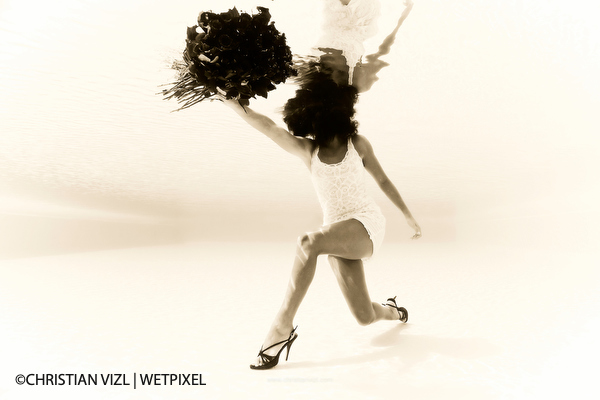
You talked about a turning point when your friend left you with a video camera, and that was what prompted you to shoot for yourself, to create images, and as your career progressed, were there any other big turning points where you felt like this has really changed either how you shoot, or how you felt about it, or how other people view your work?
Yeah, it has evolved in many different shapes and forms and, at the beginning, I didn’t even share my images because it was such a personal work. I never dreamed or thought about becoming an underwater photographer, professionally. Everything just happened organically and then sometimes I started to share an image on Facebook because my friends were telling me “ahh this is very nice” and at that time my Facebook was super personal and then maybe I’d upload one image to Facebook and then suddenly I got this friendship request from people I didn’t know. At the beginning I didn’t accept them, but then I started to look closely and a lot of them, they had diving in their profile pic, so I thought maybe they saw my picture, and it started to organically grow. And at some point I was doing something else in Mexico City, but I was only thinking about my next dive trip, my next photography trip, and it became, not an obsession because that’s a strong word, but I was only able to focus on the next trip, and I was kind of neglecting what I was doing at that time because, if I was I was present there, or physically there, my mind was on underwater photography. So then I needed to take a decision, because if I wanted to pursue a career in underwater photography and leave everything I was doing, then it was important to start to enter contests. I don’t really believe in contests between humans, especially in photography because it’s such a subjective point of view to say this is a good or bad photo. But I understood that if I wanted to continue this path it was important to enter contests and to win them and to start to build an underwater photography career.
And then…well of course when I was a little kid I was always enchanted by the ocean and no one at that time realized that we could empty the oceans. We perceived the ocean as so big, so immense, it was maybe only a few ‘crazy’ people (or we thought they were crazy at the time) who said; “what are we doing?” But now I can see all the changes, all of the ways that we have affected the ocean, I have seen them first hand. And I have read a lot, watched a lot of documentaries, spoken to a lot of scientists all over the planet…so…when I opened my eyes to this terrible reality that created another change in my career. Because now I believe that the only truly great purpose for my images is to serve conservation and to be a voice for the ocean because it really needs our help. We are the ones who are supposed to love the ocean and all its animals, the underwater photographers, so I think it’s very, very important that we first get to know what is going on. All the problem that the humans have created, all the pressure that we have put on the ocean, and then start to take some action because if not, it’s going to be too late.
The ocean faces many threats, what would you say is the single biggest threat to life in the sea right now?
For life in the ocean: it’s overfishing. There was a story, I think in 2007, about the United Nations, and in that story, they stated that if we continue the level of consumption of animals in the ocean, by the year 2048, we will deplete all life in the ocean. 2048…that’s not far away…and since 2007, the rate of consumption has only increased and increased. We tend to blame illegal fishing for all the problems that we are creating in the ocean, but I think the problem is over-consumption. As long as there is consumption, there will be all type of fishing: legal, illegal, sport fishing (which is also so big now in the world). And people think “oh but I only bring one fish out” - yeah but there are so many billions of people around the planet that it’s just too much for the animals in the ocean to replenish themselves. So that’s one of the biggest problems of course.
Another is that, with the plastic, with the micro-plastic, which is the biggest problem in the ocean regarding plastic. It’s not the one floating at the surface that kills millions of birds and mammals and marine life every year… It’s actually not the most dangerous one. The most dangerous plastic in the ocean is the one which is already degraded into tiny particles. Very recently, no more than fifteen years ago, we learned that more than half of the oxygen that we are breathing is produced by micro-organisms in the ocean. And in 2015 some scientists, for the first time, they recorded these animals feeding on our microplastics. And even though they are tiny, they absorb all the dangerous chemicals in plastics. So we are actually killing the very animals that we rely on to live.
Global warming is a big problem because all of the animals in the ecosystem of the ocean have a tolerance for temperatures. That’s why we have already lost more than half of the world’s corals. In only one year, 2015, the year of the El Nino, we lost 30% of the world’s corals. And you know, we are talking about it like a mathematical thing, but just stop for a second and let that sink in: “wow…50% of the world’s corals are already gone because of what we are doing to this planet”. They took millions of years to form and to develop…and now they are gone…because they only tolerate to a certain degree the changes in temperature.
Also, we are changing the chemistry of the ocean, the pH; the acidity is changing, because the ocean is absorbing all of the excess carbon dioxide that we put in the air. So it’s like ourselves, we can tolerate a certain degree of change in our bodies’ pH, but only to a certain level.
You represent beauty in your underwater images, but the things we’re talking about are ugly. What do you think is more effective — an image of beauty or the ugliness to motivate people to protect the ocean?
That’s a fantastic question, and I thought a lot about it, a lot. Months. And my decision was that there are already a lot of really ugly images around and I am grateful or them, that people have taken the time, and patience and conscience to share that with the rest of the world. And many people have changed their point of view because of many of these images, and I think it’s great that they are there, but we have to keep the balance. Because if the only thing we are going to show is destruction and ugliness, these sad images to see, I don’t think that’s also good, because then you discourage the people, they lose hope, they say “no, the problems are too big.” So I decided that my way of going towards conservation was through love and through beauty. To say, “ok, this is worth saving,” “this is worth fighting for,” “this is worth making some personal changes in my own life to try to not contribute any more to the destruction of all the ecosystem.” And at the end, we need to understand that our own lives are completely interconnected and dependent on the health of all the ecosystems. If we kill these ecosystems, we are actually killing ourselves. We are committing massive suicide, and we don’t even realize.
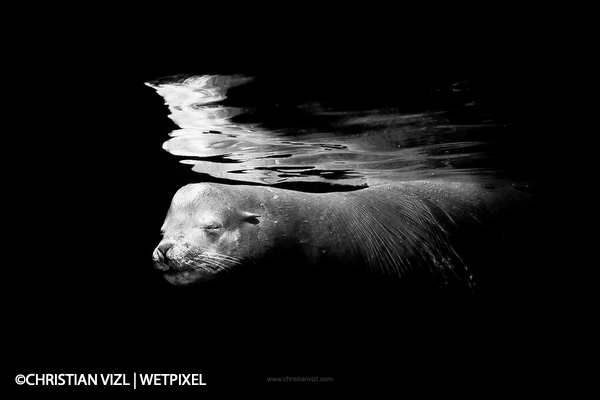
HS: Which single image are you proudest of?
That’s a tricky question….that’s a very hard one…but I am more proud of the moments that I have spent with some animals, where I was able to connect somehow with them, those are the moments I treasure. And in terms of pictures, maybe the pictures that came out if those encounters. Now it came to my mind — a sea lion, in La Paz, Los Islotes, four years ago.
What was the interaction?
Ah, no because the male sea lions they have a role in their lives and their role, amongst many others, is to protect the females, and to protect their territory, and to protect their cubs during the season when they are born. So they take very good care of their job and if we, as people, are transgressing in any way, they can, and they will become aggressive to us. They will first signal us; “Hey you’re too close” or “hey you need to back-up,” they will let us know, so you need to be very respectful. So one day I was the last one to be in the water, it was late in the afternoon, perfect afternoon, no breeze, the sea was calm, like a mirror, and then suddenly one of these males he started to circle me around. Circle and circle, and every time he was getting closer and closer and closer. So I didn’t move, and I was just taking pictures from time to time, but he kept doing it and doing it, and he ended up some inches away from me. And then suddenly he completely relaxed, stopped, and he even closed his eyes, and only from time to time took his nose up to breath, then come back again. So, I felt like the luckiest man alive because he allowed me to be that close to him, it was his choice, and he felt it was ok, that I was no threat and…oh that was nice…that feeling. So maybe yeah, the pictures that come out of those sessions I have the strongest emotional tie to.
Is there a particular animal that you most enjoy shooting?
Yeah, I love shooting sharks, it’s always exciting and fun. I love also shooting sea lions, spending time with them. I never get bored, they are so fun, and they are always doing amazing stuff, and I love watching them because they have such a great life, individually and all of them. The females are very tender towards each other, the cubs are super playful, they demonstrate how much love they have for each other - the cubs, the mother, it’s such an amazing community. Sometimes you see them in the open ocean, and even as they are hunting they are having fun, they are playing all the time, it doesn’t get any better than that. I envy their lives.
You have such a distinctive style to your images, how did it evolve?
Actually, at the beginning, I was a little bit shy to start shooting in the ocean because I’ve seen so many underwater photographers in my life and I was thinking what’s the point of shooting another image that’s going to be another one amongst the thousands that are already there. I didn’t see any value to that except being with the animals. So at the beginning, I was a little bit confused in that sense…because I also love photography and I think we should try to create something interesting and unique. At the beginning I started shooting in pools, I tried to create different concepts. At the beginning, it was with my girlfriend, or nephew put them in the pool and try to create something fun.
Actually the first underwater image that I took was by chance because I was kayaking to a place that I go a lot to in Mexico on the Pacific, and I only took my mask and snorkel to do some freediving, and I saw this beautiful scene underwater, some rocks and a lot of fishes, and I was like “Ohh, I want to take a picture of that! I want to put that into a frame”. So I came back the next day with my camera, and that became my first underwater picture. And from there I couldn’t stop.
And of course, since my first rolls that I bought in photography, were black and white. My first images that I started to print were in black and white. And there wasn’t a particular style, I was trying my best. And as I started to be more active, I tried to create ways to create visually attractive images. Images that were not the usual ones. I was not actually thinking about creating my own style, that was not the quest, it was just to create interesting images for me. Because if I’m going to put time and effort into that, I want to do it as best as my abilities can.
So I started to play, this and there, and of course it’s important always to interact with other photographers, art, to get inspired. So I got inspired by many other underwater photographs that I saw, and that’s how eventually I started to find this unique way. For me, it was a very nice way to bring out the image from a RAW file. Because the way I look at the images when I download them is, “ok I did all this effort, technically, and I did the trip, I went to see the animals, I tried to do my best composition underwater…you know, put all my effort”. Once you shoot, now the picture, is the picture, and it has a life of its own, that’s the way I see it. And now, when I look at it on the computer, I ask myself “what does this picture need in order to bring out the best that the image can?” So each image is individual, I cannot put like a preset to do the images the way that I do them because each one has a unique way that needs to be presented. In my opinion, of course, it’s always our opinion!
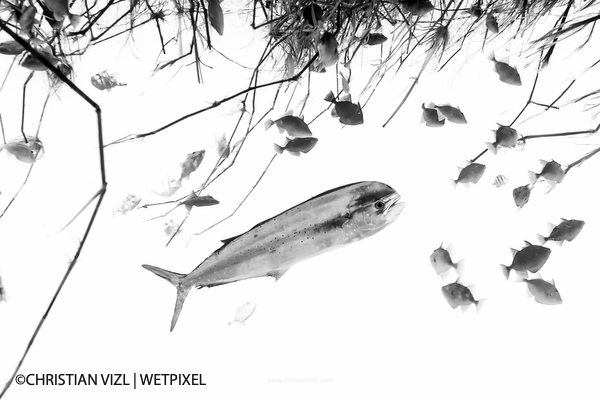
For me, when I think of Christian Vizl images, it’s black and white, it’s unique compositions, and then that editing, that post-processing style - you see it and either you know it’s your image, or it’s someone who has been influenced by your work. What do you use for your editing? And how did you learn to do it in the way that you do?
I only use Lightroom for my post-production, and I learned Lightroom on a webpage called linda.com. On there you have very structured courses for everything you could imagine, all kinds of software, and they create these amazing videos with modules…so that’s an amazing way for me to learn because I can do it whenever I want, have my own rhythm. So that’s how I learned the basic technique, how to move all the sliders, what they were for…But that’s just the first step because you need to go further and beyond that and try to figure out how to apply them: all these possibilities that we have today in modern photography. You need to learn how to apply them in a very creative way in order to bring the best out of our images - that’s the trick. I see, the first step in creating an image, when you take the RAW file, that’s the first step, and it’s a creative process, but I also think post-production is the same or more creative than taking the actual image. What you do with that image is a super creative process. But I guess most people don’t see it that way. I guess most of the people see it as a mechanical or technical thing that they need to do to their images…and I don’t see that, I see it as a super creative process where you can put a lot of yourself into the image, what you want to say with image and how you want to say it.
What messages would you like to give to aspiring underwater photographers in terms of creating better images?
First, we need to build on our passion, if the passion is not there. Then, you need to establish a certain degree of technicality, but until a point. And that point is whenever you feel comfortable knowing what you are doing with the camera and Lightroom. But then, we need to forget about technique and not be so conscious about it. Because the next step is to let your creativity flow and to try to produce unique images. Sometimes, when I go and shoot a super, super easy animal that’s been so photographed, like a whale shark, it’s very interesting because when you have thousands of photos of the same animal with all the different angles and situations, then it becomes a challenge - how can I create something unique, new, fresh? The single most valuable advice that I got in photography was from an interesting professor that lives in Mexico City, and he was telling me that, in his opinion, seeing as there are millions of photographers in the world, why are there just a handful that transcends with their photography? And, in his words, he said that most of the photographers go to the zoo (that was his example) and take pictures of the zoo, but the ones who transcend with their photography are the ones who go to the zoo and take pictures of how they felt during their visit to the zoo. And that’s the game changer. When you can connect with yourself, with your emotions, your passion, and your love for whatever you are photographing. Once you pass your technical aspects and you are good at them, you pass way beyond that. Try to connect those technical abilities with your sensitivities, with your passion, with your view of the world. That’s when you put your own personal opinion into the pictures, and that ’s massive when that happens.
What projects do you have coming up?
Well, I’m very happy giving my ocean conservation talks, they have gone very well, and sometimes I get people that come to me and say “you just changed my life” so that’s very good to keep inspiring people. That’s a wonderful aspect of photography, the way we can communicate with others and through our images we make people feel. At the beginning I wasn’t realizing that, because I thought “I’m taking pictures for me” you know, but then as I shared them more and more on social media I started to understand that link that we have when we put one image out there — that people, through our images, are actually feeling something, and it’s wonderful when we can help them to have these amazing images of love, passion, or surprise, or amazement…so many emotions that they go through with our images. That’s a part that I enjoy a lot. I also have a book coming, it’s going to be my first book, it’s only about black and white photography underwater, and it’s going to be released in April 2019. And hopefully keep working in ocean conservation, supporting a lot of NGOs which are doing a great job, I have friends that I respect a lot because they actually risked their own lives to protect the ocean - so I hope to support them where I can.
To see more of Christian’s stunning work, please visit his website, or his [Instagram] (https://www.instagram.com/christianvizl/?hl=en) and Facebook feeds.
About the author
Henley Spiers is an award-winning underwater photographer and writer with an unquenchable passion for the sea. Half British and half French, he lives in Cebu, Philippines, with his wife (and favorite dive buddy) Jade and their daughter Apolline. To see more of his work check out his website or follow him on Instagram or [Facebook]:(https://www.facebook.com/henleyspiersphotography)
To see more of this interview and other interviews, please see Henley Spiers’ blog.